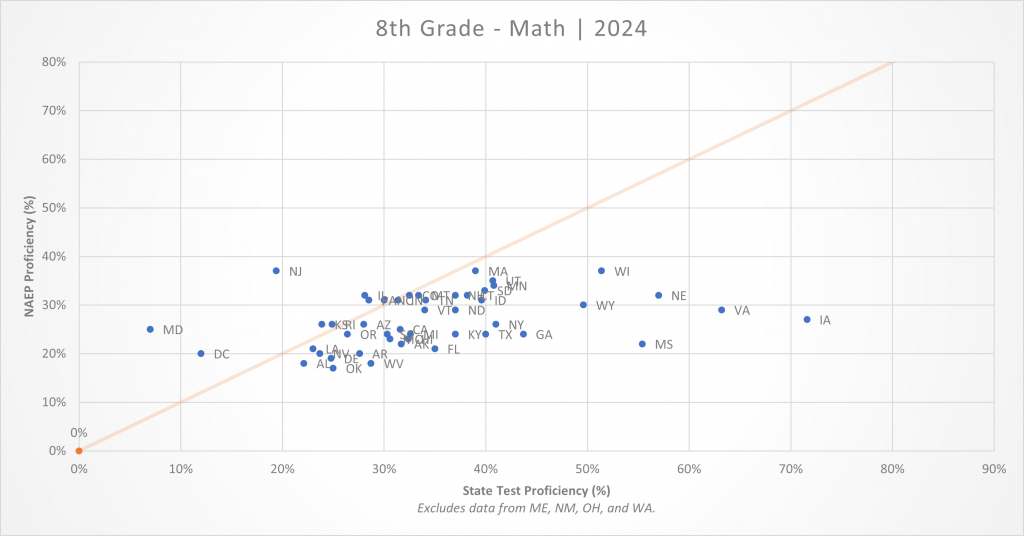Latest “Honesty Gap” Analysis Shows Parents Continue to Be Misled About Student Academic Performance

Latest “Honesty Gap” Analysis Shows Parents Continue to Be Misled About Student Academic Performance
Only Two States Eliminated “Honesty Gap” in 2023-2024 School Year
Most states continue to prefer a more lenient definition of learning proficiency than that shown by the National Assessment of Education Progress (NAEP) – also known as the “Nation’s Report Card.” That’s the takeaway from the most recent Honesty Gap analysis, an effort led by the Collaborative for Student Success comparing state-reported student proficiency scores to scores from the 2024 nationally administered NAEP.
In many states, this gap is significant, creating a misleading picture of student achievement. For example, Iowa’s 2024 state-reported 8th grade math proficiency rate is 72%, while NAEP reports only a 27% proficiency rate – a 45-percentage point difference. Similarly, Virginia’s 2024 state-reported 4th grade reading proficiency rate is 73%, while NAEP reports only a 31% proficiency rate – a 42-percentage point difference.
“If we believe that NAEP is indeed the Nation’s Report Record on student proficiency, then we would hope there is little difference between the outcomes on the two tests,” said Jim Cowen, Executive Director of The Collaborative for Student Success. “But that’s not the case. In many states, the gaps suggest that parents simply aren’t getting the full picture of how prepared their kids are for college or the workforce.”
There are bright spots. Massachusetts and Rhode Island closed their gaps to within 5 percentage points or less across both grades and subjects. In addition, 14 states are holding students to an equal or higher standard than NAEP in at least one grade or subject.
And as a trend, states have improved. In 2014, 23 states (AK, AR, AZ, DE, GA, HI, IA, IN, LA, MD, MI, MS, ND, NE, NH, NV, OH, OK, OR, RI, SC, TX, WA) had the “biggest honesty gaps” in 4th grade reading – defined as 30 percentage points or larger. In 2024, only Alabama, Iowa, Nebraska, and Virginia have gaps as large in 4th grade reading. In 2014, 14 states (AK, AR, DC, DE, GA, IA, IN, LA, MS, NE, OH, PA, SC, TX) had “the biggest honesty gaps” in 8th grade math – which we defined as 30 percentage points or larger. But in 2024, only Iowa, Mississippi, and Virginia have gaps that large in 8th grade math.
“To be clear, improving student outcomes takes huge commitments from states on efforts like high quality curriculum, strong teacher development and student supports,” said Cowen. “But the truth matters. We salute the states that are embracing the issue rather than masking it or running away from it.”
Notably, Virginia has committed very publicly and explicitly to addressing the lower expectations, wider gaps and lack of transparency stifling student progress. The state redesigned its school accountability and accreditation system, committed significant funding to high dosage tutoring and literacy instruction and is now reviewing the rigor of the state assessment.


Major report findings:
- In 42 states, the gap between the state and national assessment was double digits (10 percentage points or more) in at least one subject and grade level. Parents and education stakeholders should use caution when referring to or inferring meaning from these results.
- Some states continue to dramatically mislead the public about student proficiency rates in one grade/subject area. Six states report proficiency rates to the public that far exceed student proficiency according to NAEP in at least one grade or subject area (30 percentage points or more): AL, IA, MI, MS, NE, and VA. Parents and education stakeholders in these states should advocate for more rigorous benchmarks of success or more accurate tests.
- 14 states have eliminated their Honesty Gaps in at least one assessment. These states held students to a higher proficiency standard than NAEP; as a result, their reported proficiency scores were equal to or less than state NAEP scores in one or more assessments. 11 states eliminated The Honesty Gap in 4th grade math (CO, DC, FL, IL, KS, MA, MD, NC, ND, RI, and VT), and three states in 4th grade reading (FL, MA, and RI). Nine states eliminated The Honesty Gap in 8th grade math (DC, KS, MD, NJ, NC, IL, IN, PA, and RI), and two states in 8th grade reading (KS and TN). While parents and education stakeholders should be cautious when referring to other state test results, they can trust these as presented.
- In Massachusetts and Rhode Island, the gap between state and national expectations was 5 percentage points or less across both grades and subjects. Parents in these states can trust the state test results as presented.
State assessment data for four states (ME, NM, OH, and WA) are excluded from The 2023-2024 Honesty Gap because they have either not yet released 2024 assessment data or the data was released in grade spans, making comparisons to NAEP data inaccurate.
Explore the Full 2024 Honesty Gap Snapshot
About the Collaborative for Student Success
At our core, we believe leaders at all levels have a role to play in ensuring success for K-12 students. From ensuring schools and teachers are equipped with the best materials to spotlighting the innovative and bold ways federal recovery dollars are being used to drive needed changes, the Collaborative for Student Success aims to inform and amplify policies making a difference for students and families.
To recover from the most disruptive event in the history of American public schools, states and districts are leveraging unprecedented resources to make sure classrooms are safe for learning, providing students and teachers with the high-quality instructional materials they deserve, and are rethinking how best to measure learning so supports are targeted where they’re needed most.

